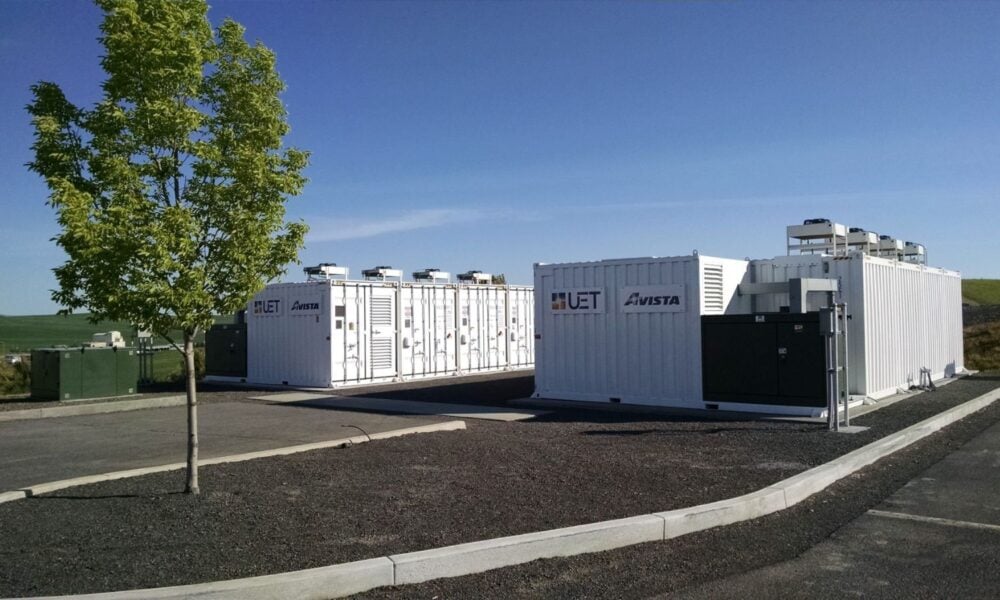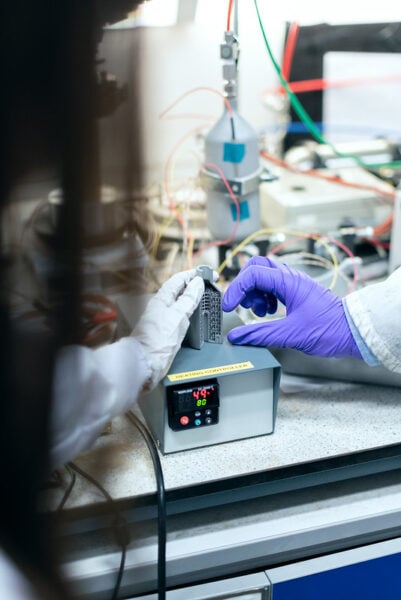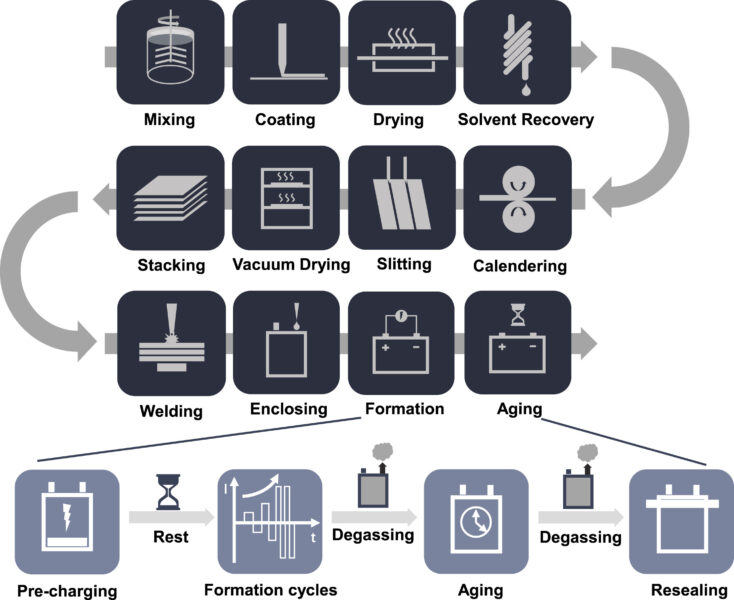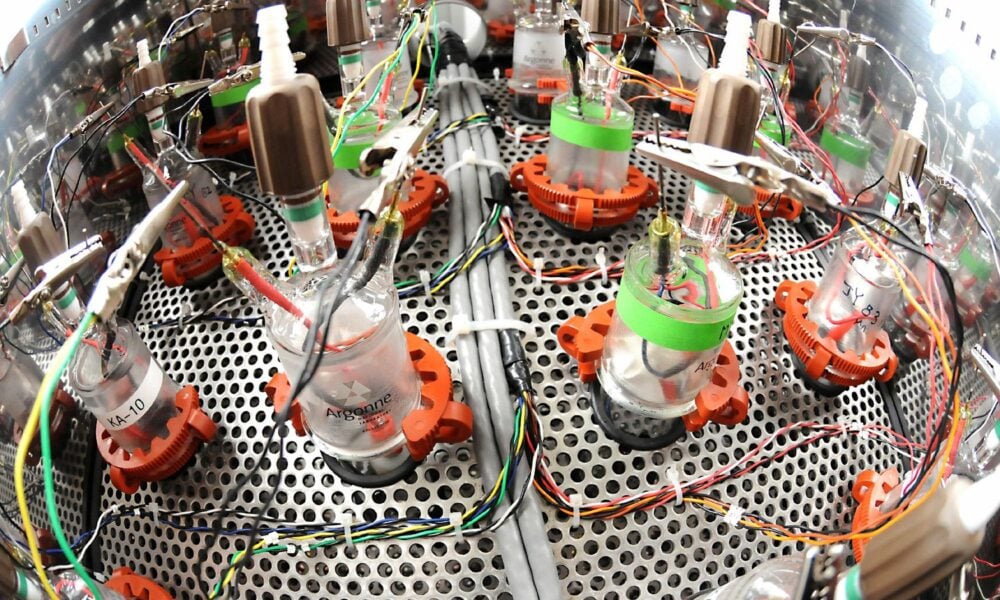The renewable energy transition involves harnessing epic forces of nature. Sleek solar panels forged from silver and silica from the depths of the Earth translate the sun’s blindingly fiery light energy into electricity. Wind turbines with blades each the size of a 12-story building punctuate the skyline of wind-swept fields and help power entire cities.
What is one of the most valuable tools for making all of this possible? What secret weapon is a critical enabler of this dramatic energy transition?
Batteries.
 A 1 megawatt vanadium flow battery (a different technology from lithium-ion, but also used for energy storage) is in Pullman, Washington, built by UniEnergy Technologies and owned by Avista Utilities. Source: UniEnergy Technologies/Wikimedia Commons
A 1 megawatt vanadium flow battery (a different technology from lithium-ion, but also used for energy storage) is in Pullman, Washington, built by UniEnergy Technologies and owned by Avista Utilities. Source: UniEnergy Technologies/Wikimedia CommonsBatteries help store surplus energy. When the electric grid has all the energy it needs at a given time, but it’s a sunny or windy day and solar and wind energy systems are still generating electricity, batteries help store the surplus. Then, when the sun is down and the wind isn’t blowing, batteries can discharge that stored surplus energy to continue supporting power needs. While most energy storage for the US electricity grid today is in the form of pumped hydro systems, batteries are a growing piece of the storage pie.
The most common type of battery used in grid energy storage systems are lithium-ion batteries. Finding their original niche in laptops and cellphones, lithium-ion batteries are lightweight and can recharge thousands of times without losing significant capacity. This makes them a perfect candidate for fueling electric vehicles (EVs), which dominate the lithium-ion battery industry today. Currently, there is about 35 times more lithium-ion battery capacity in electric vehicles than in grid energy storage globally (700 gigawatt-hours (GWh) vs. 20 GWh). Therefore, most lithium-ion batteries used for energy storage today are built using the same supply chains and processes as EVs, given the EV industry’s larger economies of scale.
Most lithium-ion batteries in the world today are used in electric vehicles but more and more are being used in battery storage systems for the power grid. Source: UCSWhat are the building blocks of a lithium-ion battery?
Lithium-ion batteries include five components: an anode, a cathode, a separator between the anode and cathode, an electrolyte solution that transports the lithium ions, and current collectors made of copper and aluminum that connect the battery to wires.
The anode is typically made of graphite. The graphite is mixed until it is completely uniform, then coated onto aluminum foil. When making the cathode, the two most common chemistries are those that contain cobalt (either nickel-magnesium-cobalt or nickel-cobalt-aluminum) or those that don’t and instead contain lithium-iron-phosphate. For either type, the metal mixture is blended until uniform and coated onto copper foil. The coated foils are then compressed using rollers, then slitted into strips.
Assembling the components
In a typical lithium-ion battery, the anode and cathode are separately mixed with a binder to create a slurry, and the slurries are then coated on the current collectors. Once dried, the anode and cathode sheets are stacked with polymer separators placed between them. To create a “pouch cell,” these layers are alternately stacked to form a rectangle. To form a “cylindrical cell,” the layered stack is coiled. The anode at one end is welded to the negative current collector, and the cathode at the other end to the positive current collector. The system is then placed in the cell housing and the electrolyte is added.
 Engineers develop energy storage battery technologies. Source: This is Engineering/Flickr
Engineers develop energy storage battery technologies. Source: This is Engineering/FlickrTesting and activation
Charging and discharging assembled batteries—key quality activation and testing steps—take up about a third of the manufacturing process time.
 Steps to manufacture a lithium-ion battery. Source: Liu et al. 2021
Steps to manufacture a lithium-ion battery. Source: Liu et al. 2021To calibrate the battery to the exact current and voltage needed, the cell is charged and discharged with precisely tuned amounts of electricity. At the same time, lithium ions are added to the anode. (The cathode already contained lithium from the first step of building the anode; the additional lithium ions added to the cathode are for extra stability.)
 Testing lithium-oxygen in glass chambers at at Argonne National Laboratory. Source: Argonne National Laboratory/Flickr
Testing lithium-oxygen in glass chambers at at Argonne National Laboratory. Source: Argonne National Laboratory/FlickrFinally, the cells go through an “aging” process, which looks similar for both EVs and grid energy storage batteries. For a period often lasting several weeks, the battery’s voltage is monitored to ensure stability and test for any malfunctions or degradations over time. Once the battery looks up to code, it is off to the grid to power our renewable energy future!
Battery energy storage is powerful and growing
Battery energy storage can help store clean energy for the grid. Additionally, another smaller-scale advantage of batteries is their use in “mini-grids,” which can help individuals and communities keep the lights on for extra hours when the grid falls temporarily offline due to blackouts or natural disasters.
Batteries can also be used to assist with peak electricity demand; currently instead of batteries, fossil fuel-powered “peaker plants” are often used to supply energy during high-demand periods. Despite being used infrequently, these plants are inefficient and highly polluting, and contribute to US carbon emissions. Replacing peaker plants with battery storage systems will be a big win for US climate action and public health. In an energizing recent example from August 2022, Tesla Powerwall batteries across thousands of California homes pooled electricity and supported the grid when demand was very high.
The industry is growing. From 2020 to 2021, large-scale US battery storage system installations tripled from 1.4 to 4.6 gigawatts. Wood Mackenzie estimates that the US will add more than 63 gigawatts more batteries by 2026. That increased energy storage system deployment will boost research in battery technologies designed specifically for grid storage, including new types of lithium-ion batteries and alternatives.
Fleets of batteries—acres and acres of unassuming stationary metal boxes—are a key to unlocking the renewable energy future. But are batteries, themselves, renewable? Can they be reused or recycled at the end of their life? Where do their raw materials come from, and how can we ensure their valuable contents are recovered rather than wasted? Click to learn more!
Challenges and Opportunities in Mining Materials for Energy Storage Lithium-ion Batteries
Want Clean Energy? Then You Also Want Battery Recycling.
And what about the solar panels and wind turbines that generate the electricity that batteries store? Check out our previous posts on solar panel and wind turbine life cycles!

 1 year ago
212
1 year ago
212
